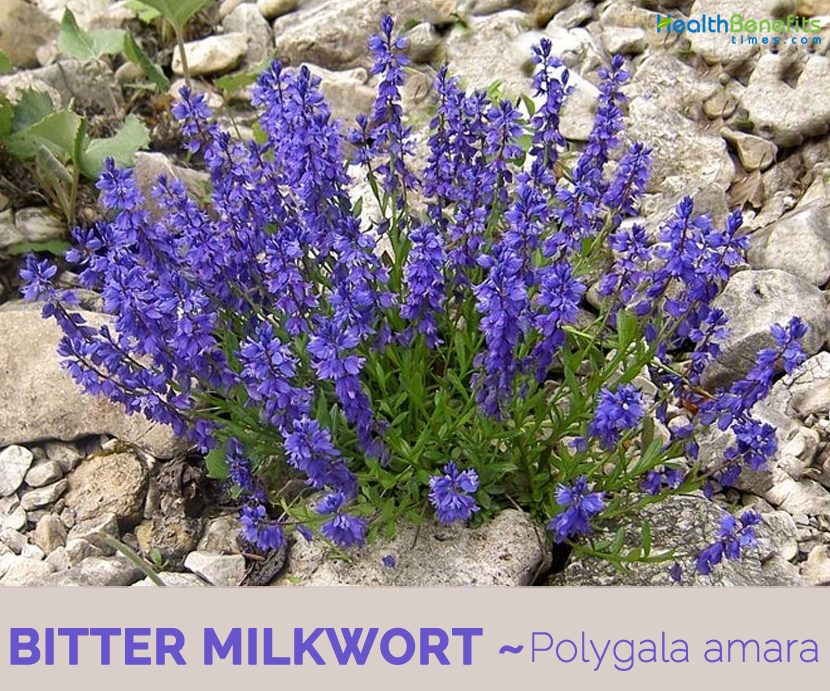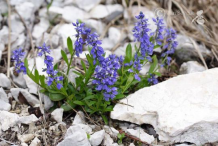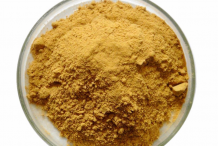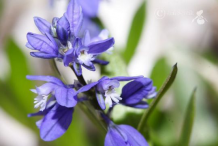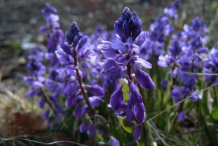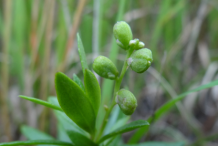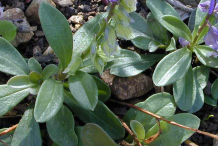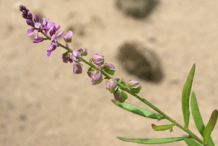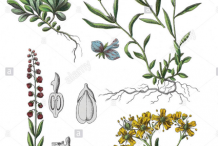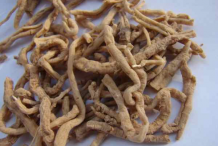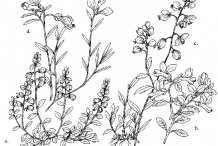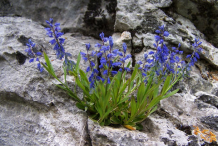Plant Description
Bitter Milkwort is a perennial, flowering plant that grows about 5 to 15 cm high. The plant is found growing in grassland and Damp Mountain pastures, especially on chalk and limestone. The plant prefers moderately fertile moisture-retentive well-drained soil. The stems are branched at the base, decumbent or ascending. The basal leaves form a rosette, while the cauline leaves are alternate, oblong-cuneate or obovate-lanceolate. The leaf blades are smooth edged and undivided.
Flower and Fruit
The blue or occasionally white or pink flowers are in many-blossomed racemes. Of the 5 sepals, the 2 lateral ones are large, petal-like, patent and 3-veined. The other 3 are smaller; die middle vein is green. The 3 petals are fused together with die stamens. These form 2 clusters in 2 green pockets on the larger, lower petal. The 2 upper petals form a kind of upper lip. The ovary is superior and bilocular witfi a spoon-like style. The fruit is an obcordate capsule, compressed at die sides and enclosed in the sepals. The fruit consists of two black seeds.
Bitter milkwort is taken for respiratory problems such as cough and bronchitis. It has chemicals that can thin mucus and make it easier to remove the mucus from your sinuses. However, there is inadequate evidence that shows whether bitter milkwort is truly effective for such use. Some mothers also use Bitter Milkwort to increase milk flow during breastfeeding, but there is not enough research available to prove the use safe for pregnancy and breastfeeding.
Other Informations
Simple infusion of 2 teaspoons of plant in 1 cup of boiling water for 15 minutes is an exceptional remedy for inferior and medium respiratory tract diseases and chronic lung problems. Used for bronchitis, for allergic and/or infectious asthma, or in cases of wet or dry cough, the infusion administered as hot as possible, twice a day, cleans your airways and has an antispasmodic effect, calming cough episodes.
An old cure for indigestion, dyspepsia or liver problems is the Bitter Milkwort Wine which you can prepare at home from 1 liter of white wine, 5 tablespoons of Bitter Milkwort, 1 tablespoon Wormwood and 1 teaspoon of cinnamon, macerated for 12 days and filtered. Take one small glass of this wine before a meal.
Traditional uses and benefits of Bitter Milkwort
- People take bitter milkwort for breathing problems, cough, and bronchitis.
- It is commonly used for cough, chronic bronchitis and other chronic lung problems arouse a sluggish appetite.
- Nursing mothers may increase milk flow after using bitter milkwort.
- It is effective in treating various respiratory problems including convulsive cough and bronchial asthma.
- It is also used for stomach, kidney and bladder disorders, amenorrhea and rheumatism.
- Extended use of small doses has the opposite effect of relieving chronic diarrhea.
- The herb is bitter, diaphoretic, diuretic, emollient, mildly expectorant, galactogogue.
- An infusion made of bitter milkwort flowers can be used to treat upset stomach and even bladder and kidney conditions.
- Seneca Indians have made a tea from bitter milkwort as a remedy for coughs, sore throat and colds.
- It is used for insect bites and stings.
- Roots of the Bitter Milkwort are chewed and applied on the snake bitten area.
- Early tribes have used it to induce abortions.
- An old cure for indigestion, dyspepsia or liver problems is the Bitter Milkwort Wine.
- Healing herb is used to trace chickenpox.
Ayurvedic Health benefits of Bitter Milkwort
- Cough: Boil 4 tbsp leaves of Polygala Amara in one cup of water for 2-3 hrs. Cool and take one tbsp every 3 hrs. OR Boil 100 g of Polygala Amara root in ½ liter of wine. Boil it for 10 minutes. Allow it to cool for 2 hrs. and then decant. Drink one tsp 4 times a day.
- Bronchitis: Put 1 tsp of shredded, dried Polygala Amara in boiling water. Steep it for 20 minutes. Strain and drink it 4 to 5 times a day.
- Asthma: Add 1 ½ tbsp of dried powder of Polygala Amara in the boiling water. Steep it for 15 minutes. Strain and drink it 4-5 times a day.
- Expectorant: Mix 1 tbsp dry powder of Polygala Amara in 100 ml of boiling water. Allow it to cool for 15-20 minutes. Decant and drink it in 5 to 6 innings a day.
- Whooping cough: Add 1 ½ tbsp of powdered Polygala Amara in a cup of water (200ml). Boil for 4 minutes. Leave it covered for 20 minutes. Strain and drink one tsp at a time when needed.
- Croup: Prepare a decoction of 2 g Polygala Amara in 300 ml of water. Boil for 5 minutes. Leave it covered for 10 minutes and then strain. Drink 3 cups in a day.
Other Facts
- Bitter milkwort is used medicinally but is not consumed as food.
- Dakota and Winnebago would carry the root into snake infested regions.
Precautions
- Higher doses may lead to toxicity.
- High doses may result in vomiting and diarrhea.
- It should be taken with precautions by those suffering from gastritis and gastric ulcers, as it exacerbates mucosal inflammation in the segment of the gastrointestinal tract.
- The use of the herb should be avoided by pregnant women.
Preparation, Dosage and precautions
- For infusions: Add 1 tsp of dried plant (root and/or aerial parts) in a cup of hot boiled water. Drink 1 cup a day.
- For Decoction: Add 4 tbsp of dry leaves in ¾ cup of water and boil for at least 15 minutes. Take 1 tbsp every 3 hrs.
Dosing considerations for Bitter Milkwort
Appropriate dose of bitter milkwort depends on several factors such as the user’s age, health, and several other conditions. At this time there is not enough scientific information to determine an appropriate range of doses for bitter milkwort. Keep in mind that natural products are not always necessarily safe and dosages can be important. Be sure to follow relevant directions on product labels and consult your pharmacist or physician or other healthcare professional before using.
References:
http://www.theplantlist.org/tpl1.1/record/kew-2565892
http://www.pfaf.org/USER/Plant.aspx?LatinName=Polygala+amara
Comments
| Bitter milkwort Quick Facts | |
|---|---|
| Name: | Bitter milkwort |
| Scientific Name: | Polygala amara |
| Origin | Europe, Asia also in South America and Africa |
| Shapes | Capsule that is sometimes winged in appearance |
| Taste | Bitter |
| Health benefits | Beneficial for breathing problems, cough, and bronchitis, kidney and bladder disorders |
| Name | Bitter Milkwort |
|---|---|
| Scientific Name | Polygala amara |
| Native | Europe, Asia also in South America and Africa |
| Common Names | Milkwort, dwarf milkwort , European Bitter Polygala, European Senega, Evergreen Snakeroot, Flowering Wintergreen, Little Pollom, Polygala amara, Polygala Amère, Polygale Amer, Snakeroot |
| Name in Other Languages | Croatian: Gorki krestušac, krestušica gorka, krestušica krstašica Czech: Vítod hořký Danish: Bitter mælkurt English: Milkwort, dwarf milkwort French: Polygala amer German: Bitteres Kreuzblümchen, Sumpf-Kreuzblume Hungarian: Keserű pacsirtafű Italian: Poligala amara Polish: Krzyżownica gorzka Romanian: Amăreală Russian: Istod gor’kiy (истод горький) Slovak: Horčinka horká Slovenian: Grenka grebenuša Spanish: Polígala amarga, hierba de leche amarga Swedish: Bittert jungfrulin, bitter fagelört |
| Plant Growth Habit | Perennial, flowering plant |
| Growing Climate | Grassland and damp mountain pastures, especially on chalk and limestone |
| Soil | Prefers a moderately fertile moisture-retentive well-drained soil |
| Plant Size | 5 to 15 cm high |
| Stem | Branched at the base, decumbent or ascending |
| Leaf | Basal leaves form a rosette, while the cauline leaves are alternate, oblong-cuneate or obovate-lanceolate |
| Flowering Periods | Jun to August |
| Flower | Usually reddish purple, yellow or white |
| Fruit Shape & Size | Capsule that is sometimes winged in appearance which contains two black seeds |
| Taste | Bitter |
| Plant Parts Used | Aerial parts, roots |
| Available Forms | Infusion, decoction |


